The Final Update: Flash Video Performance on Ion
by Anand Lal Shimpi on May 26, 2009 12:00 AM EST- Posted in
- Anand
It must be because this thing is so darn tiny that I don’t mind testing it all the time, but today’s short update marks the third follow up to our original Zotac Ion review.
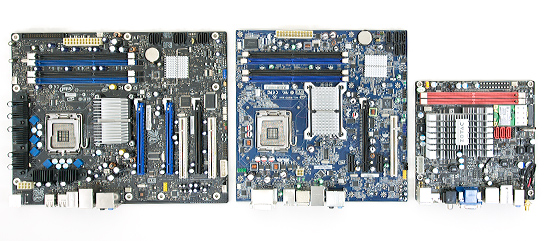
The original article crowned the Zotac Ion as the best Atom based mini-ITX board I’d ever encountered. It wasn’t a hard feat to accomplish, after all, there are only two other Atom based mini-ITX boards on the market and neither one offers a real GPU.
The first follow up addressed questions that readers of the first article had. Looking into things like the overclocking potential of the platform and additional detail on power consumption.
The second follow up addressed the Zotac’s wake-on-USB support, or lack thereof. Today I’m publishing what I hope to be my last update on this hardware until I get a new revision, but as always if there’s something you’d like to know don’t hesitate to ask.
Wake-on-USB Support: The Explanation
Zotac has been very proactive with getting me updates on its motherboard, I have their excellent North American PR rep to thank for that :)
As I mentioned in the last update, the Zotac Ion board won’t wake up from a S3 sleep state after activity on a USB device (e.g. moving your mouse, hitting a button on a media center remote, etc...). Zotac listed the problem as being a hardware issue that won’t get fixed until the next revision of the motherboard; early adopters are out of luck. I now have an explanation as to why.

The USB ports on the current version of the motherboard (PCB version 00) are powered by the 5V rail from the motherboard. When the motherboard goes into a S3 sleep state, 5V power is shut off, so the USB ports are completely off.
In the next revision of the motherboard (PCB version 01) standby power will be connected to the USB ports, allowing the ports to still be alive when the board is in S3. The manual shows you where you can identify what PCB revision you have.
I’m guessing externally powered USB hubs are able to pull the system out of sleep since the USB device is still on, but a USB device connected directly to the motherboard will be completely powerless in S3. The explanation makes sense to me; if you were wondering, now you know.
Flash Video Playback on the Ion: Delving Deeper
I personally get most of my “TV” from Hulu so I completely understand the desire to know how well Intel’s Atom and the Ion platform in general perform when playing back Flash Video.
A few readers requested that I look deeper into the Ion’s FLV performance, especially when the Ion was overclocked. I had some spare time today so I did just that.
In my first follow up article I found that the Ion could play, without a problem, standard sized 360p and 480p Hulu videos. Attempting to increase the video window size to full screen yielded a highly unplayable video. I wanted to investigate further.
I used the latest version of Adobe’s Flash 10 player as well as Internet Explorer 8 under Windows Vista Ultimate 32-bit. With a desktop resolution of 1360 x 768 I tried five tests:
1) 360p, video window popped out and maximized to desktop resolution
2) 360p in Hulu’s full screen mode
3) 480p, video window popped out and maximized to desktop resolution
4) 480p in Hulu’s full screen mode
5) 720p playing a Hulu HD video
I ran the five tests in two configurations; first with the Atom 330 at its default 1.60GHz clock speed and second with the Atom overclocked to 1.92GHz (the highest stable frequency I could overclock the Atom to).
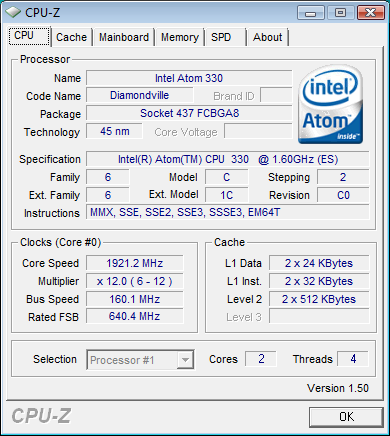
My impressions are in the table below:
| Scenario | Atom 330 @ 1.6GHz | Atom 330 @ 1.92GHz |
| 360p, maximized window | Some tearing, lower frame rate than default window, perhaps slightly smoother with hardware acceleration turned off? | Totally watchable, definitely lower frame rate but watchable |
| 360p, full screen | Totally unacceptable, not really higher CPU utilization than with a maximized window, but too choppy - distracting | Passable, not perfect but it can work if you can ignore some of the choppiness |
| 480p, maximized window | Slightly lower frame rate than the 360p test, but better picture quality so this may be a better option for some. Still annoying to watch due to lower frame rate. | Improved, I think passible. |
| 480p, full screen | Lots of tearing, somewhat more bearable than 360p full screen thanks to improved picture quality. I still prefer maximized window for higher frame rate. | Still choppy. |
| 720p HD | Completely unwatchable, CPU utilization > 90% | Still choppy but a bit better, painful but technically watchable |
While hardware acceleration was enabled in the Adobe Flash Player 10 settings, I can’t say that I noticed a performance difference with it enabled or disabled. I’m not really sure what it’s doing but it definitely didn’t help keep my framerate smooth when upscaling video.

CPU utilization was around 64% when watching a 360p stream in a maximized window
The only situation I would consider 360p full screen Hulu to be passable is when the system was overclocked to 1.92GHz. You’re far better off maximizing your browser window and dealing with the application border than running in Hulu’s seamless full screen mode.
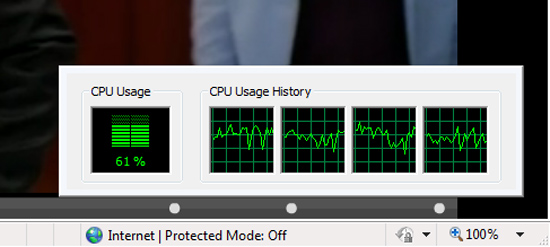
Overclocking the Atom dropped it to 61%, a small difference but noticeable
I will note that Hulu has difficulty playing in full screen on much faster systems as well, so I’m not sure we can really blame the Atom or Ion for its performance limitations here. It appears that video scaling under Flash is just not very efficient.
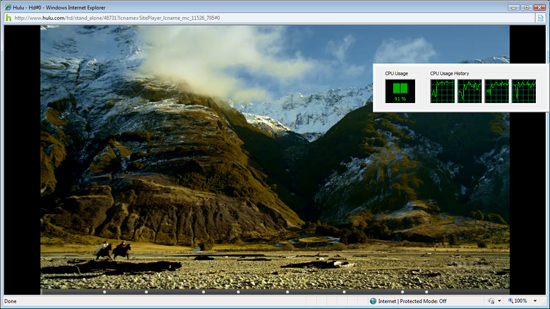
Hulu HD was basically unwatchable thanks to a > 90% CPU utilization
The HD stream is unplayable at stock frequencies but not because of scaling issues, since there's actually much less scaling being done from 720p to 1360 x 768. The HD stream falls victim to the Atom's limited CPU power, which overclocking helps overcome. I do still think that HD Hulu playback is too much for even an Atom 330 unfortunately.
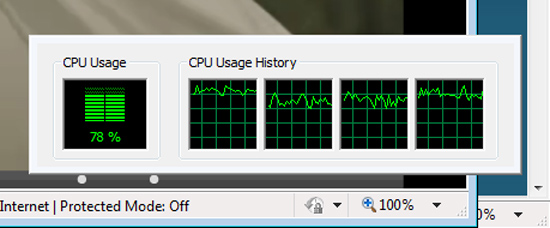
Overclocked, even HD hulu saw a benefit as CPU utilization dropped to below 80%
Overall the overclocking helped, but don’t expect any miracles. Be happy with smaller Hulu window sizes or be doomed to feel unfulfilled it seems. If NVIDIA wants a good case for CUDA, give us smooth FLV playback at any resolution and I'll be happy :)
With that said and done, it’s back to CPUs and SSDs for me.










56 Comments
View All Comments
extremsparen - Thursday, June 4, 2009 - link
Does anybody know, if the new hardware revision is out now which supports Wake on USB? If so, has the new IONITX-D series this feature from the beginning of production? How should I check the revision elsewise before buying such a board?Fanfoot - Friday, May 29, 2009 - link
Too bad, as in many ways an Atom-based TV-side Media Center PC would be a great choice. Cheap enough that they might become more common, low power, quiet. With Ion you get the HDMI interface you need. Yet even then full screen scaling defeats things.I don't see the point in trying other browsers. I would instead try the new Hulu windows application, though I suspect things won't be any different.
It does sound like a combination of things can be done to make this acceptable--overclocking, shrinking the screen size, an SSD drive (see jkkmobile's review of the new RunCore Pro IV SSDs, another one using the indilinx controller), or some combination thereof.
Or maybe we'll all just have to wait. Will the 2.0GHz Pineview's do the job in the fall? Will Adobe fix this anytime soon? I guess we'll see.
Thanks for keeping the heat on the issue though.
icrf - Friday, May 29, 2009 - link
Anand, can you try the Hulu Desktop Beta that was released yesterday? I suspect that may get around a lot of the in-browser performance issues, especially with full-screen scaling. I haven't tried it yet, but plan to shortly.icrf - Friday, May 29, 2009 - link
Scratch that, it's still just flash, so all flash scaling issues remain. I just tried it at home and my E6600 is still sufficiently unhappy with WQXGA scaling, so I wouldn't expect much different on the Atom. I did find that if I right click and drop flash's quality from "high" to "low" that it plays perfectly smoothly, but as expected, the image has jaggies. Honestly, I'll take jaggies before dropped frames. From looking at it, it's almost as if the jaggies I'm seeing is the real resolution of the source video, "high" quality is just trying to smooth it out. Apparently it does this badly, so it's not too surprising it drops frames in the process.crabnebula - Thursday, May 28, 2009 - link
Even on my Athlon dual core HTPC, full screen Flash Video upscaled to 1080p is painful.Those of you who want to overcome this might want to try PlayOn. It is a DLNA media server that can serve up Hulu and others to any DLNA compatible-device or software, such as a PS3 or an Xbox 360. There are at least two DLNA clients available for Windows Media Center (PlayIt and Tubecore), and WMP also works.
mode101wpb - Thursday, May 28, 2009 - link
The Atom 230 with GMA950 can handle 720P if it's devoid of flash. I had the same issues with youtube and hulu in HD mode. I can also play DVDs with no issues.Flash just sucks the life out of it.
The only solution for youtube is to download the HD content and watch it.
jonbach - Thursday, May 28, 2009 - link
I have one of the Zotac samples as well. Hulu is fine in windowed mode, but not full screen. While I agree that is certainly a problem, I personally feel this is neither a NVIDIA or flash problem, but a Hulu problem. I've had the same problems on my home PC and laptop -- full screen Hulu is problematic. As far as I understand, the video playback is indeed GPU accellerated, but the upscaling to fullscreen is not. My laptop runs 1680x1050, and even with a 9650GT video card and dual core P9600 CPU, it can't reliably handle full screen playback. But its buggy -- it will play fine until I pause, and then following that it is choppy. ION definitely has the firepower to do it, evidenced by that fact that there is only ~10% CPU usage while playing 1080p blu-ray content. I personally think Hulu has some work to do, because other sources of HD content play just fine, even on flash. It plays this video ( http://harrypotter.warnerbros.com/harrypotterandth...">http://harrypotter.warnerbros.com/harrypotterandth... ) just fine, with under 20% CPU usage, which points me to the possiblity -- is Hulu encoding in something other than H.264? And whatever that codec is, perhaps it does not support accellerated scaling.BUT until Hulu does make improvements, that's a moot point. The fact is, if you're getting the ION for Hulu playback, ION isn't going to cut it at this point in time. I have to think that Hulu is working on this though.
shiznit - Thursday, May 28, 2009 - link
Anand, thank you for all the work informing us about the Zotac Atom 330 + Ion board, you have covered almost all of my bases in regards to deciding if this board will be good enough for my first HTPC build which is long overdue.I have one more question though. I will still be watching many dvds and I need to know if the Atom 330 can handle upscaling to 1080p through ffdshow. I know some of the post processing filters can hog even a quad but if you could test resize to 1920x1080 with some NR that would be fantastic and answer the final question many of us have about using this platform for HTPC. Thanks.
Rainman200 - Wednesday, May 27, 2009 - link
Flash HW acceleration is really a poor choice of naming for what it actually does which is GPU composting and scaling, that is not GPU based video decoding in the sense of DXVA.Flash is not just video that's the problem, its a framework that is a pig when it comes to performance any way its being used, I've seen CPU spikes just from flash banner advertisements.
What might be worth checking out if yo update your article with tests is the silverlight HD video demos, MS have used them in a few sites and the performance is much better than Flash video.
http://www.iis.net/media/experiencesmoothstreaming">http://www.iis.net/media/experiencesmoothstreaming
http://roland-garros.france2.fr/?page=exclusif_HD
danwallie - Thursday, May 28, 2009 - link
Rainman200, I agree, we need to see how this board can handle Netflix's excellent Silverlight application.